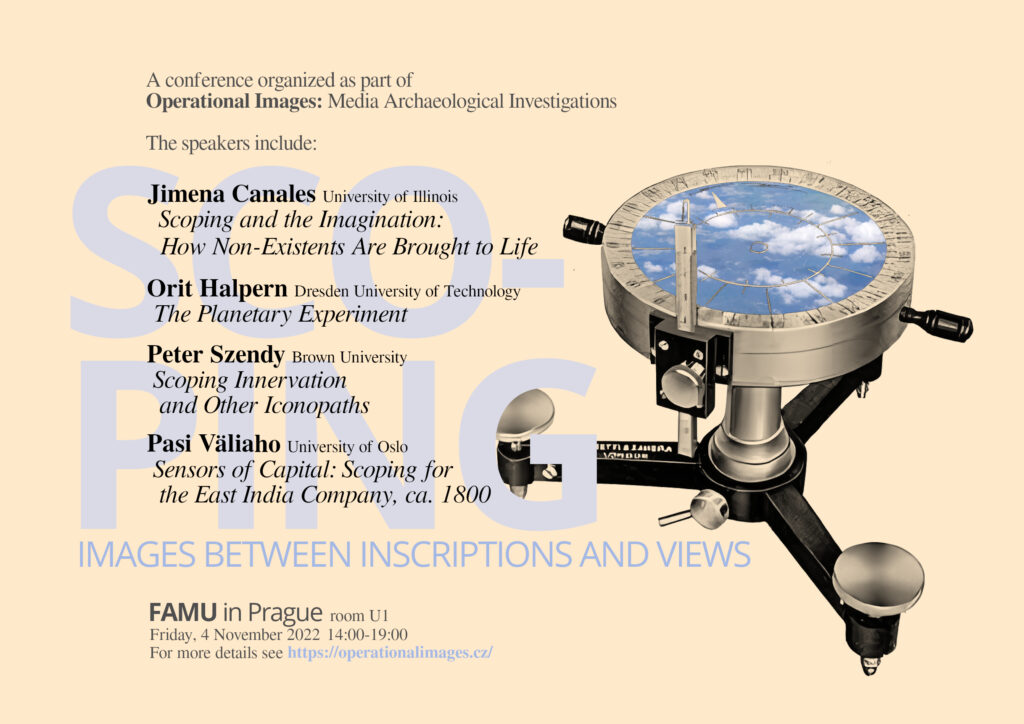
4 November 2022, 14:00 – 19:00
FAMU in Prague, room U1 (https://goo.gl/maps/KUfWeTxJRtNLrj627)
No registration/ticket needed.
Jimena Canales has unfortunately had to cancel her participation. The event will start at 14:00 as planned.
- Opening Remarks – Tomáš Dvořák (FAMU in Prague)
- Scoping and the Imagination: How Non-Existents Are Brought to Life – Jimena Canales (University of Illinois, Urbana-Champaign)
- The Planetary Experiment – Orit Halpern (Dresden University of Technology)
- Scopic Innervation and Other Iconopaths – Peter Szendy (Brown University)
- Sensors of Capital: Scoping for the East India Company, ca. 1800 – Pasi Väliaho (University of Oslo)
- Concluding Remarks – Jussi Parikka (FAMU in Prague & Aarhus University)
In studies of visual technologies, most attention has been paid to devices and apparatuses that generate images or inscriptions. In addition we can identify an equally important and diverse family of visual technologies that produce certain kinds of “views”. The difference could be described by referring to the Greek terms “graphein” and “skopein” or rather them being used as suffixes in the names of many instruments (e.g. radiograph and radioscope). Whereas the -graphs typically make images or traces, the -scopes are used to observe, monitor and examine things in real-time and in close connection with them. From telescopes or microscopes to a large number of medical but also other viewing devices, fixed images can be produced but are not necessary. They enable momentary gazing at or into something, a continuous inspection which intimately couples the observer with the observed.
While “graphing” predominantly leads to static and lasting pictures, “scoping” is dynamic, although of a very different kind than the traditional dichotomy of static and moving images (such as photography and film) might invoke. It involves not only movement but also various modulations, transformations and rescalings of the subject. Scoping is a peculiar sort of viewing. It is a durational encounter and always in a sense “on”; it is available for another look. It has a peephole-like character. One typically looks “inside” into something that cannot be seen with a naked eye (even when watching stars with a telescope we are looking “inside the universe”). The viewing instrument tightly entangles the observer with the observed and requires expert training and skill to see something at all. Scoping is aimed at an individual specimen, whether an object or a process, looking at it carefully, eyeing or scanning it in order to evaluate, investigate or examine it.
Although this regime of scoping manifests itself in scientific instruments, we can relate it to other visual media as well, such as the emphasis on “views” in early photography or cinema. Furthemore, contemporary operational images do their work of observing, monitoring or examining in the mode of scoping, belonging to the family of -scopes rather than of -graphs, which might be one of the reasons we doubt they can be considered images at all. This dichotomy is, however, only heuristic.
Our conference seeks to investigate such peculiar forms of viewing while simultaneously addressing the current as well as historical relationships between images and views, between inscriptions and heavily mediated glimpses into the hidden layers of reality.